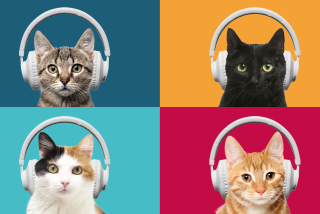On to the next wave in radio
- Share via
As the audience for AM and FM radio declines, start-up entrepreneurs and giant media companies alike are searching for the “next radio” -- a way to make money by helping listeners discover new music. Online music providers such as Pandora, Imeem and Last.fm provide an early glance at that next chapter in radio history.
The search for a user-customized music “station” started in the early 1990s, when MIT’s Media Lab created Ringo, a music recommendation engine that asked listeners to grade a few tunes and then offered them songs they might like. Now, CBS’ Last.fm site has become the first of the new generation of music sources to offer free, on-demand, full-length spins of any tune you want to hear -- not just the 30-second snippets available on iTunes and most other music sites.
As in other areas of media, the music industry is finally starting to come around to the difficult truth that we now live in a world in which consumers expect information and entertainment to be free. Efforts to sell music by subscription have mainly failed. (Yahoo recently gave up on its Music Unlimited subscription service and sent its customers to Rhapsody, another struggling music provider.) But traditional radio’s offer of free music surrounded by audio advertising is also being rejected by a generation that resents undesirable interruptions.
“They want to be the program director, and they insist that the program be free,” says Jerry Del Colliano, a professor of music industry at USC and a former executive at Top 40 WIBG in Philadelphia. “Young consumers don’t have that need that we older folks have to have someone knowledgeable about the music tell them what’s new. They have their social network to tell them what’s cool.”
Bring on what’s new
With increasing evidence that many people suffer from iPod fatigue -- they know too well what’s stored on their player and they crave surprise -- several companies are trying to figure out what blend of user-generated content and expert guidance will attract an audience.
Since 2005, Tim Westergren has crisscrossed the nation gathering fans of Pandora, his site that lets listeners create their own stations by typing in a favorite song or artist and letting the software generate a stream of music that shares their favorite’s characteristics. Based on a handcrafted database that catalogs more than 500,000 songs according to their rhythm, harmony, mood, style and lyrics, Pandora serves up selections that you then fine-tune by rejecting those you loathe and embracing those you adore.
While Pandora’s choices can be repetitive and the company has struggled mightily against the imposition of potentially devastating royalty rates, the service has a strong, intensely loyal following -- and Pandora is a consistently effective way to find music you didn’t know you’d like.
For those who recoil at the notion of anyone -- a radio station program director or Pandora’s musicologists -- deciding what music is best for them, Last.fm chooses tunes in a different way. Rather than employ its own experts, Last.fm relies on the collective listening habits of its users. When you choose a song on the site, you see a list of artists who are “similar;” if many people who joined you in listening to Booker T. and the MGs also listened to the Delfonics, the software leads you in that direction.
Last.fm’s great promise may lie down a path the company is not yet traveling. Will CBS use its $280-million acquisition to change some of its 140-plus AM and FM radio stations, putting listeners in charge of what music gets played? Or is that really no answer to radio’s woes? Does online crowd-sourcing really produce dramatically different playlists from the traditional market research that radio stations engage in and that listeners love to whine about?
A whole new mind-set
Patrick McKinnon, 27, a computer engineer in Austin, Texas, is a fan of the new music sources that created a mash-up that lets listeners use Last.fm in combination with Slacker, a new entry in the field that has one big advantage: It’s portable -- a $200 player connects to your personalized stations by WiFi.
“I often hear people from my parents’ generation say, ‘There will never be another Beatles,’ and they are absolutely correct,” McKinnon says. “Not because there will never be another band capable of making music as well as the Beatles, but because we no longer have to form our musical preferences based on a limited number of competing radio stations. We now have millions of people making millions of choices about what they want to listen to; it becomes rather improbable that a large majority will gravitate to the same conclusions about what music they prefer.”
That may be the ideal, but the reality looks a lot more like hit radio. The top artists on Last.fm for a recent week were Radiohead, the Beatles and Red Hot Chili Peppers -- not exactly acts unknown to FM radio. Indeed, on the most popular online music sites, the lists of most popular songs are almost indistinguishable from what’s on most pop or hip-hop radio stations.
At Imeem.com, the 10 most-played songs include two Sean Kingston numbers and two by Lil Wayne; the service’s pop list is tighter than most FM playlists, with three Fergie tunes and two Avril Lavigne songs in the Top 10.
Suggestion engines based entirely on listeners’ choices don’t generally produce exotic and creative options. Rather, they reproduce an all-too-familiar drive to the lowest common denominator. Listen to avant-garde jazzman John Zorn’s “Batman” on Imeem, and the service steers you next to the DNA remix of Suzanne Vega’s “Tom’s Diner” and from there to Bananarama’s “Cruel Summer” and a long stream of ‘80s pop heavy on Laura Branigan (“Gloria”).
No suggestion-driven music service has become a dominant force. Del Colliano believes only Apple could produce the next radio -- something providing the serendipity of radio delivered through an infrastructure that already enjoys mass acceptance.
Del Colliano and other observers increasingly believe the radio of the future will not be a 24/7 music source but rather a provider of short programs, such as podcasts, that appeal to an ever-shrinking attention span and work seamlessly with social networks, cellphones and laptops.
Whatever form the next radio takes, it’s clear what need it will fulfill. “Every day I am bombarded with new and interesting technologies competing for my already limited time,” McKinnon says. “Having the ability to turn on a personal radio station that will grow and evolve as new music becomes available, tailored accurately to my musical preferences, will be truly amazing. It isn’t here yet.”


